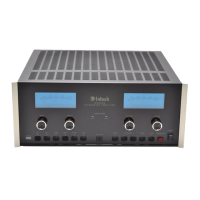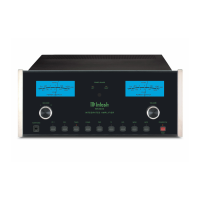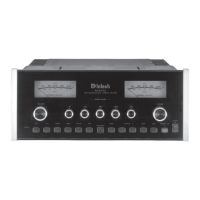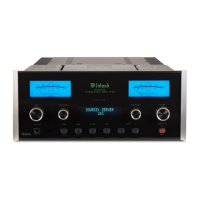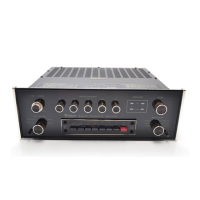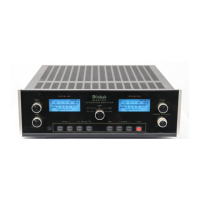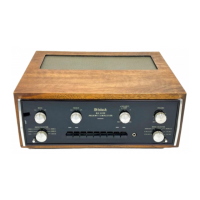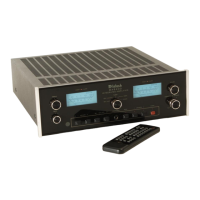12
Connecting Components
The MA/MAC6700 has the ability to automatically
switch power On/Off to McIntosh Source Compo-
nents via the Power Control (Trigger) connections.
The Data Port Connections allow for the remote
operation of basic functions using the MA/MAC6700
Remote Control. With an external sensor connected
to the MA/MAC6700, remote control operation of the
system is possible from another room and/or when the
MA/MAC6700 is located in a cabinet with the doors
closed.
If the optional Tuner Module is to be installed into
the MA6700 (the MAC6700 Tuner Module is factory
installed) please proceed at this time to the installa-
tion procedure located on the separate folded sheet
“Mc1B”.
The connection instructions below, together
with the MA/MAC6700 Input and Output Connec-
tion Diagrams located on the separate folded sheet
“Mc2A/2B”, are an example of a typical audio
system. Your system may vary from this, however the
actual components would be connected in a similar
manner. For additional information refer to “Connec-
tor and Cable Information” on page 5.
Note: Source components may be connected to the
MA/MAC6700 Balanced Inputs or Digital Inputs
instead of Unbalanced Inputs. Refer to Setup
“Reassigning Inputs” to activate them on page
22.
Power Control Connections:
1. Connect a Control Cable from the MA/MAC6700
PWR CTRL (Power Control) MAIN Jack to the
Power Control In on the Turntable.
2. Connect a Control Cable from the McIntosh Turn-
table Power Control Out Jack to the Audio/Video
Player Power Control In Jack.
3. Connect a Control Cable from the Audio/Video
Player Power Control Out Jack to the SACD/CD
Player Power Control In Jack.
4. Optionally connect a Control Cable from the MA/
MAC6700 PWR CTRL (Power Control) TRIG
(Trigger) 2 Jack to the Power Amplifier (Second-
ary Room) Power Control In Jack.
Note: The default setting for the TRIG 2 Jack is
“MAIN”. Refer to Setup “Power Control Trig-
gers 1 and 2” on page 24 to change TRIG 2 set-
ting to “OUTPUT 2”.
5. Connect any additional McIntosh Components in a
similar manner, as outlined in steps 1 thru 3.
Data Control Connections:
6. Connect a Control Cable from the MA/MAC6700
CD DATA PORT Jack to the SACD/CD Player
Data In Jack.
7. Connect a Control Cable from the MA/MAC6700
DVD DATA PORT Jack to the Audio/Video
Player Data In Jack.
8. Connect any additional McIntosh Components in
a similar manner, as outlined in steps 6 thru 7.
Sensor Connection:
9. Optionally, connect the cable with stereo mini
plug coming from the compatible External Sensor
to the EXT CTRL (External Control) IR IN Jack
on the MA/MAC6700. Refer to page 5 “General
Information, note 7” for additional information.
Audio Connections:
10. Connect Balanced Cables from the MA/MAC6700
BAL (Balanced) L & R Connectors to the SACD/
CD Player Fixed Audio Output Balanced Connec-
tors.
11. Connect Audio Cables from the MA/MAC6700
DVD INPUT Jacks to the Audio/Video Player
Output Jacks.
12. Connect the Audio Cables coming from the Turn-
table to the MA/MAC6700 MC (for a Moving Coil
Cartridge) or MM (for a Moving Magnet Cartidge)
INPUT Jacks.
13. Optionally, connect Audio Cables from the MA/
MAC6700 OUTPUT 2 Jacks to the Power Ampli-
fier (Secondary) Input Jacks.
14. Connect any additional Components in a similar
manner, as outlined in steps 10 thru 13.
Optional Digital Audio Connections:
15. Connect a Coaxial Cable from the MA/MAC6700
DIG (Digital) 1 Digital Audio Input Jack to the
Digital Out Coaxial Jack on the Audio/Video
Player.
16. Connect an Optical Cable from the MA/MAC6700
DIG (Digital) 2 Digital Audio Input connector to
the Digital Audio Out Optical Connector on the
SACD/CD Player.
Optional USB Connection:
17. Connect a USB cable with (type A to type B) con-
nectors from the MA/MAC6700 USB D/A Digital
Audio Input to an available USB connector.
Ground Connections:
18. Connect the Ground Cable coming from the Turn-
table to the MA/MAC6700 GND Binding Post.
Notes: 1. If the MA/MAC6700 is part of a Home Theater
System, proceed to “PassThru” connection on
page 13.
2. When the MA/MAC6700 will used together
with a separate Power Amplifier for Bi-Am-
plification of a Loudspeaker System, proceed
page 16.
Connecting Components
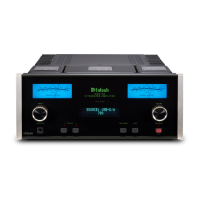
